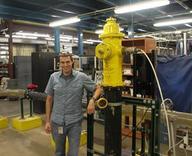EPA Research Updates
EPA researchers are using their expertise to help states, tribes, and local governments with per- and poly-fluoralkyl substances. These chemicals, known as PFAS, do not break down easily in the environment and can have implications to human and environmental health. EPA researchers are helping communities identify and reduce PFAS chemicals at sites around the country.
For
communities living close to industry, air pollution emissions may be a concern
to health and well-being. EPA researchers are working with industry, states, and
communities to develop low-cost and portable technologies that can be deployed
next to an industrial complex for emissions testing. The goal is to modernize
how emissions sources are managed so EPA can better protect the environment and
save companies money.
EPA is working with grantees to develop predictive toxicology
tools. These virtual tissue models,
sometime referred to as “Organs on-a-chip,” provide a pathway for the
development of new prediction techniques. They also have the potential to reduce dependence on
animal study data and contribute to faster chemical risk assessments.
Burning oil spills has been a fast and relatively safe way to reduce the impact on water quality and marine life. However, burning oil can impact air quality and the oily residues left behind in the water can cause environmental damage. EPA and the Department of Interior’s Bureau of Safety and Environmental Enforcement are investigating ways to improve oil burn procedures that can lead to more efficient burning and less emissions and residue.
Since the Nation’s primary
chemical management law, the Toxic Substances Control Act (TSCA), was amended in 2016, EPA researchers have been providing support for several important
TSCA activities. EPA has met several key
milestones and continues to move the state-of-the science forward. With the
translation of this information for policy-makers and other stakeholders, a new
era of chemical safety is becoming a reality.
Meet Our Researchers
 Meet EPA Scientist Jeff Szabo, Ph.D.
Jeff Szabo recently won an Arthur S. Flemming Award for his contributions to water infrastructure decontamination. He was instrumental in the design and construction of the Water Security Test Bed at the Idaho National Laboratory, a platform for performing drinking water security experiments in a setting that resembles real water pipes in the ground without any public health risk. His research also helped water systems respond to chemical spills in West Virginia in 2015 and Texas in 2016, and several oil spill incidents across the nation. Learn more about his work.
|
Events
Science Matters is produced by the U.S. Environmental Protection Agency, Office of Research and Development. All content is copyright free and can be reprinted without permission.
Questions or comments? Send us an email.
EPA Research | EPA Science Matters
You can view or update your subscriptions or e-mail address at any time on your Subscriber Preferences Page. All you will need is your e-mail address. If you have any questions or problems e-mail subscriberhelp.govdelivery.com for assistance.
This service is provided to you at no charge by U.S. Environmental Protection Agency.
|